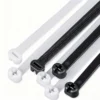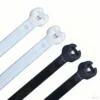1. What are Metal Tooth Cable Ties?
Metal tooth cable ties, also known as metal tooth zip ties, represent a key upgrade to traditional nylon cable ties. The core improvement lies inside the locking head: a stainless steel metal tooth replaces the standard nylon pawl. This design ensures tighter engagement with the tie body, effectively preventing slipping or breakage under pressure. Therefore, metal pawl cable ties are especially suitable for harsh environments with strong vibrations, temperature variations, or long-term stability requirements, such as automotive manufacturing, rail transit, and wind energy wiring applications.
2. Structure Composition
Metal tooth cable ties are usually composed of two core parts:
• Tie Body:
Made of high-strength nylon, it provides excellent tensile strength and necessary flexibility, making it easy to thread and install on-site.
• Locking Head:
The internal cavity houses a stainless steel metal tooth. The tooth meshes tightly with the teeth of the tie body to form a secure mechanical self-lock.
Working Principle:
Cable ties with metal lock adopt a one-way insertion design, fundamentally preventing backward loosening after tightening. The metal locking tooth is located at the key stress point inside the head, automatically increasing its grip as the tie is pulled—achieving a “the tighter, the stronger” effect. This hybrid design of a nylon body and metal locking head combines the lightweight advantage of nylon with the durability of metal for outstanding performance.
3. Material Analysis
| Component | Material of Metal Tooth Cable Ties | Features and Description |
|---|---|---|
| Tie Body | Nylon 6 | Good flexibility, low moisture absorption, suitable for normal temperature and medium-strength applications. |
| Nylon 6.6 | Higher strength and better heat resistance, recommended for outdoor and industrial use. | |
| Metal Tooth | 304 Stainless Steel | Common type with excellent oxidation and corrosion resistance, ideal for most industrial environments. |
| 316 Stainless Steel | Contains molybdenum, resistant to salt spray and chloride corrosion, ideal for marine, chemical, and high-humidity applications. |
Summary: Nylon 6/6.6 provides toughness and insulation, while the metal tooth offers locking strength and stability, achieving both light weight and reliability.
4. Specification Table of Metal Tooth Cable Ties
| Type | Length | Width (mm) | Max. Bundle Dia. (mm) | Min. Tensile Strength |
|---|---|---|---|---|
| Inch | mm | lbs / kgs | ||
| WD-3x100MT | 4″ | 100 | 3 | 20 lbs / 9 kg |
| WD-4x150MT | 6″ | 150 | 4 | 40 lbs / 18 kg |
| WD-4x200MT | 8″ | 200 | 4 | 40 lbs / 18 kg |
| WD-5x200MT | 8″ | 200 | 4.8 | 50 lbs / 22 kg |
| WD-5x250MT | 10″ | 250 | 4.8 | 50 lbs / 22 kg |
| WD-5x300MT | 12″ | 300 | 4.8 | 50 lbs / 22 kg |
| WD-5x380MT | 15″ | 380 | 4.8 | 50 lbs / 22 kg |
| WD-7x300MT | 12″ | 300 | 7 | 50 lbs / 22 kg |
| WD-8x175MT | 7″ | 175 | 7.6 | 100 lbs / 45 kg |
| WD-8x200MT | 8″ | 200 | 7.6 | 100 lbs / 45 kg |
| WD-8x240MT | 9.6″ | 240 | 7.6 | 100 lbs / 45 kg |
| WD-8x300MT | 12″ | 300 | 7.6 | 100 lbs / 45 kg |
| WD-8x350MT | 15″ | 350 | 7.6 | 100 lbs / 45 kg |
| WD-8x400MT | 16″ | 400 | 7.6 | 100 lbs / 45 kg |
| WD-10x300MT | 12″ | 300 | 9.8 | 100 lbs / 45 kg |
| WD-10x350MT | 15″ | 350 | 9.8 | 100 lbs / 45 kg |
| WD-10x400MT | 16″ | 400 | 9.8 | 122 lbs / 55 kg |
| WD-10x450MT | 18″ | 450 | 9.8 | 122 lbs / 55 kg |
| WD-10x500MT | 20″ | 500 | 9.8 | 122 lbs / 55 kg |
| WD-10x550MT | 21.6″ | 550 | 9.8 | 122 lbs / 55 kg |
| WD-10x600MT | 23.6″ | 600 | 9.8 | 122 lbs / 55 kg |
5. Comparison with Standard Nylon Cable Ties
| Comparison Item | Standard Nylon Cable Ties | Metal Tongue Cable Ties |
|---|---|---|
| Locking Teeth | Nylon plastic pawl | Embedded stainless steel tooth |
| Tooth Durability | Easily worn, affected by temperature | High durability, 2–3 times longer lifespan |
| Head Quality | May slip or break under temperature/humidity | Stainless steel head resists slipping and tooth breakage |
| Vibration Resistance | Loosens under vibration | Metal pawl locks securely, resists loosening |
| Cost | Lower cost | Higher cost |
Conclusion: Metal locking cable ties outperform standard nylon ties in locking strength, durability, and vibration resistance—ideal for long-term or safety-critical installations.
6. Application Scenarios
Metal tooth zip ties are designed for demanding and high-stability environments, performing better than standard nylon ties in the following areas:
- High-vibration environments: Designed for engines, rail vehicles, and heavy machinery. Metal pawl zip ties resist continuous vibration and prevent loosening.
- Critical safety fields: Used in wind energy, elevators, and power systems. Zip ties with metal locking tab ensure reliable performance and minimize failure risk.
- Outdoor harsh conditions: Cable ties with metal tooth resist UV exposure and temperature fluctuations, maintaining locking strength for long-term outdoor use.
- Mass production & precision work: Suitable for automotive manufacturing and data centers, supporting consistent high-tension bundling using professional tools.
- Marine and chemical industries: Recommended to use 316 stainless steel tooth version for enhanced corrosion resistance.
7. Installation Steps & Precautions
Installation Steps:
- Wrap the metal tooth zip tie around the bundle or component.
- Insert the tail into the head until the metal tooth engages.
- Pull evenly to the desired tension.
- Trim the excess tail using cable tie tools or cutters.
- Ensure the cut is smooth without sharp edges.
Precautions:
- Do not pull metal pawl zip ties backward to avoid damaging the tooth.
- Ensure smooth binding surfaces to prevent cuts or scratches.
- Use specialized tools for optimal locking effect.
- Store in a dry place away from sunlight and moisture.
- Perform secondary inspection in vibrating environments.
8. FAQ
Q1: Are metal tooth zip ties stronger than regular ties?
A: The locking head is more reliable and will not break or slip. The overall tensile strength is similar to standard self-locking nylon ties.
Q2: Will the metal tooth rust?
A: No. Metal pawl cable ties use 304 or 316 stainless steel, which provides excellent anti-rust and corrosion resistance.
Q3: Can they be reused?
A: Cable ties with metal lock are single-use self-locking designs and are not recommended for reuse.
Q4: Can metal tooth cable ties work in low temperatures?
A: Yes. The Nylon 6.6 + metal tooth structure maintains locking performance even at -20°C, suitable for outdoor cold-weather use.







